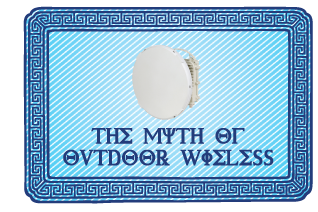20 Jan 2014 No One Really Knows the Capabilities of Outdoor Wireless
Yes, yes… the title is a little over exaggerated however in the general sense it’s true. Depending on their age, when people hear the word “wireless” they either think of the unstable network at work that keeps dropping iPhone connections or they think of a means of listing to The Archers & The Hit Parade. Although not thought of as, wireless is a viable fibre replacement especially for super-connected cities, ISPs & CCTV networks.

So what if we have to wait a few years? The government’s promised that by 2015, 90% of the UK will receive speeds of at least 24Mbps?
Glad you asked and that’s correct… The government has pledged a total of £680 million. £530 million of this will be dedicated to bringing high speed broadband to rural communities and the rest, £150 million, is being invested in the super-connected cities program. Whilst this sounds “well reem”, there are a few concerns…
The first obvious reason is the fact that time is ticking. Delivering 90% of the UK with high speed broadband is a long process with lots of planning, red tape hopping, procuring and finally installing involved. Given the fact that a 2Gbps wireless bridge (that’s Gigabit with a “G”) can be installed and fully operational within 1 day (that’s day with a “D”), it seems that the mean to the government’s end is by wireless. The only delay with a wireless bridge is applying for Ofcom licenses, which is now a thing of the past with Purdicom & MLL’s exclusive 32GHz band agreement.
When the speeds of 24Mbps are finally reached, what’s to say that the internet will be in the next stage of advancement? The bandwidth chomping HTML5 is starting to surface now bringing another whole dimension to the web with video, text, pictures & more all seamlessly (seamless once loaded) integrated into a single page. Remember when the internet was all about loading static web pages with 1, maybe two pictures? In the past 10 years we have had YouTube, Netflix & LoveFilm, internet gaming, SmartPhones, SmartTVs, tablets, cloud apps, Facebook, Twitter, iTunes, Spotify – the list could go on and on. In the early 2000s internet usage has changed beyond belief and where before a household/business being on a 256Kbit/s connection was satisfactory, today it’s deplorable. With the idea of all household/business objects being connected to the internet in the near future and Google splashing out a cool $3 billion on an Internet of Things company, the average internet usage is going to skyrocket. So is superfast only “super” by today’s terms and will it still be super in 5 – 10 years? It takes a long time replacing cable yet a wireless bridge can be replaced in, yet again, 1 day.
Maybe we’ll do it… We did it with the Olympics didn’t we?
But given Ofcom’s recent report, the divide between rural & urban broadband speed is increasing like the hyper-inflation rate in Zimbabwe. It’s the last 10% of the 90% of the UK that will be left out, operators cannot justify spending money on fibre without the requisite number of subscribers to break even. A handful of companies are turning to wireless for the last 10% and with the government expected to announce extra funds, wireless is being recognised as the way to achieve this.
The next reason is cost. Take a second to visualise connecting 90% of the UK with superfast broadband… If the Office of National Statistics estimated our population to be 63.7 million in mid-2012, then that’s 57.3 million people to be connected by 2015. Without trying to guess the exactly, you’d be able to buy a Roman Abramovich-style yacht with the amount of money it’s going to cost. The sheer equipment, planning, installation and workforce costs attached to a single fibre deployment is jaw dropping but multiply that by the amount of connections to bring to superfast broadband to 90% of the population, it seems like budgets will be eaten up rather quickly. Again wireless is much cheaper in terms of hardware, installation and ongoing maintenance. (A wireless specialist, Rapier Systems recently did a price comparison chart of Wireless vs. Leased Line to show how much money can be saved using wireless).
So why are we not seeing high speed wireless networks across the UK?
We are… Perhaps not enough but there are a handful of innovative companies, MLL Telecom and Metronet UK to name a couple, who recognise the opportunity and face-slapping business case that wireless brings to a telecoms company or ISP. This blog post is not aimed to deter the use of fibre as fibre is very fast and sometimes is the fitting solution however, there are times where wireless should be used in place of fibre. Technology moves on naturally, innovator’s designs become smaller, faster and simpler. Wireless has confidently left “beta mode” now and it’s fast, reliable and easier to install (and cheaper too).
George’s Google+ Profile